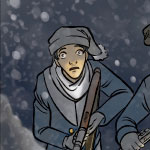Clothing

Snowshoes
Considered an indispensable piece of winter gear, snowshoes distribute the wearer's weight over a larger area, allowing the wearer to walk on top of the snow without sliding or sinking. Snowshoes are constructed from a hardwood (usually ash) frame with rawhide lacings. Green wood is steamed to make it pliable, then bent into shape. The lacing is woven in beautifully intricate patterns to create a mesh to support a person's weight on snow. Bindings attach the shoe to the foot.
The snowshoe is an invention of the natives of Aradie. The Wisdoms of the tribes claim the snowshoe is a gift from the spirits to allow them to hunt through the winter. Without the snowshoe, survival in snow-covered Everique would be impossible. The snowshoe plays a significant role in the hunting ceremonies held during winter. Their practicality so evident, the voyageurs and coureurs des bois quickly adopted them the snowshoe, and the shoe made its way into the daily life of the colonists.
The natives developed a number of designs for their shoes, giving them names inspired by animals, such as bearpaw, swallow, beavertail and rabbit-ear. The bearpaw is a smaller oval shoe for use in the thick forests. They are the most maneuverable of the snowshoes, allowing turning, spinning, and climbing. The swallow is a wide and round snowshoe made for very deep snow and slushy lakes. They are so wide that the wearer must walk with a peculiar gait. The beavertail is teardrop shaped with an upturned toe and narrow tail. The upturned toe keeps the shoe high in the soft snow while the tail acts as a counterbalance, forcing the toe up while walking. The long tail can have problems in heavy brush. The rabbit-ear is a long, thin shoe which turns up in the front and has a long tail in the back. Almost like a ski, this snowshoe allows fast travel over long distances in open country. Tribes in the Great Grass Sea have rabbit-ear snowshoes almost two meters long.

Tricorne
The tricorne (sometimes called the Cocked Hat) is a low-crowned, broad-brimmed hat that is pinned up on either side of the head and at the back, producing a triangular shape. The turned-up portions of the brim form gutters that direct rainwater away from the wearer’s face, funneling most of it over the wearer's shoulders and down the back. Cheap tricornes are made from wool felt, but most are made out of beaver fur, which is considered the best material for hats because of its tight water-resistant fur. Tricornes are decorated in a range of styles from colored trim to gold and silver lace, and sometimes include feathers. Military wearers fasten cockades on the front, denoting company and rank.
The tricorne originated more than a century ago when soldiers from the sun-drenched lands of Ilandria were campaigning in Kleef. Confronted by the constant downpours of the northern lowlands, the Ilandrians adopted the hat as a cheap alternative to actual rain gear. Due to its practicality, use of the tricorne spread like wildfire through the ranks of soldiers of Morante, Saronne, and Guern. The hat was made fashionable among the nobility by Raimon IV when we worn the hat on campaign during the War of Marbled Insults. Once this happened, every well-dressed gentleman in Saronne needed a tricorne. The need to for beaver fur soared, creating a boom in the fur trade that drove Saronnan colonization of the northern Everique wilderness.

Tuque
The tuque (pronounced tuke) is a knitted cap made of wool. Most taper to a point which is then folded over with the tip tucked into the brim, while other tuques are longer and end in a pompon. A few tuques have a rounded crown and lie close to the head and are favored by the rooks of Iniquity Row. Women sometimes wear tuques made of black velvet and trimmed with fur and lace and the occasional bow. The tuque is considered common garb and not appropriate for high society.
The tuque was first worn by the voyageurs who ply the rivers and lakes of northern Everique. The tricorne was ill-suited for the cold and rough living of the voyageurs, and a new hat was desperately needed. Into the void came the tuque, a wool cap that provides needed warmth when winter's chill winds begin to blow. By custom, the voyageurs dye their tuques bright red, and many wear charms in their caps, denoting their company affiliation or prominently displaying trade goods for any natives they encounter.
« Return to the Almanac Index

